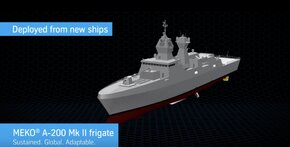For the A200 to have 32 cells- some possibilities areThe mystery deepens.
In Pat Conroy’s recent address to the National Press Club, he specifically mentioned that the number of VLS launchers in the RAN fleet was being increased to 880. Doing the numbers, that means that the GPF’s will have 32 VLS each - the A200 is only equipped with 16 so Conroy’s statement would indicate that TKMS is offering a more capable version (or the Government has already decided that they are purchasing the evolved Mogami and stating those numbers was a major slip by Conroy).
-Smaller Main Gun or removal of ?
-Removal of the 30mm secondary gun and platform forward of the bridge?
-MK II variant, a redesign of the A200 following the Egyptian order may be able to take 32 cells?
Attachments
-
328.9 KB Views: 34
Last edited:


